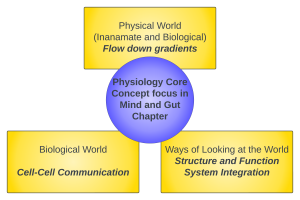Core Concepts in Physiology Mind & Gut

Physiology Core Concepts within section
Biological World
- Cell to Cell Communication – In a living organism, cells must pass information to one another to coordinate their activities.
Ways of Looking at the World
- Structure and Function – Structure and function (from the molecular level to the organ system level) are intrinsically related to each other. The functions of molecules, cells, tissues, or organs are determined by their form (structure), and function can alter structure.
- Systems Integration – Organ systems work together; understanding the functions of the organism require a consideration of how multiple entities (cell, tissues, organs, and organ systems) interact with one another to sustain the life of the organism.
Physical World
- Flow Down Gradients – The transport of “stuff” (ions, molecules, fluids, and gas) is a central process at all levels of organization in the organism, and a simple model describes such transport.
modified from
Michael, Joel, and Jenny McFarland. “Another Look at the Core Concepts of Physiology: Revisions and Resources.” Advances in Physiology Education 44, no. 4 (December 2020): 752–62. https://doi.org/10.1152/advan.00114.2020.
Media Attributions
- Blank diagram
In a living organism, cells must pass information to one another to coordinate their activities.
Structure and function (from the molecular level to the organ system level) are intrinsically related to each other.
The functions of molecules, cells, tissues, or organs are determined by their form (structure), and function can alter structure.
Organ systems work together; understanding the functions of the organism require a consideration of how multiple entities (cell, tissues, organs, and organ systems) interact with one another to sustain the life of the organism
The transport of “stuff” (ions, molecules, fluids, and gas) is a central process at all levels of organization in the organism, and a simple model describes such transport.

